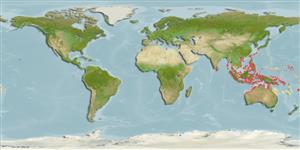Common names from other countries
Environment: milieu / climate zone / depth range / distribution range
Ecologia
marinhas; Água doce; estuarina associadas(os) a recifes; intervalo de profundidade 0 - 10 m (Ref. 86942). Tropical; 30°N - 23°S
Indo-West Pacific: Philippines, Indonesia, and New Guinea. Also from New Caledonia, north to Ryukyu Islands, and Palau in Micronesia (Ref. 1602).
Tamanho / Peso / Idade
Maturity: Lm ? range ? - ? cm
Max length : 10.0 cm TL macho/indeterminado; (Ref. 7050)
Espinhos dorsais (total) : 13; Raios dorsais moles (total) : 8; Espinhos anais: 3; Raios anais moles: 5.
Inhabits muddy inshore waters of mangrove swamps and penetrates freshwater rivers (Ref. 1602). Feeds on fishes and crustaceans (Ref. 1602). Possess venom glands at the base of some of the spines.
Life cycle and mating behavior
Maturities | Reprodução | Spawnings | Egg(s) | Fecundities | Larvas
Kottelat, M., A.J. Whitten, S.N. Kartikasari and S. Wirjoatmodjo, 1993. Freshwater fishes of Western Indonesia and Sulawesi. Periplus Editions, Hong Kong. 221 p. (Ref. 7050)
Categoria na Lista Vermelha da IUCN (Ref. 130435)
CITES (Ref. 128078)
Not Evaluated
Utilização humana
Ferramentas
Relatórios especiais
Descarregue XML
Fontes da internet
Estimates based on models
Preferred temperature (Ref.
115969): 27.3 - 29.3, mean 28.8 (based on 1625 cells).
Phylogenetic diversity index (Ref.
82804): PD
50 = 0.7500 [Uniqueness, from 0.5 = low to 2.0 = high].
Bayesian length-weight: a=0.01122 (0.00514 - 0.02450), b=3.04 (2.87 - 3.21), in cm Total Length, based on all LWR estimates for this body shape (Ref.
93245).
Nível Trófico (Ref.
69278): 4.0 ±0.66 se; based on food items.
Resiliência (Ref.
120179): Médio, tempo mínimo de duplicação da população 1,4 - 4,4 anos (Preliminary K or Fecundity.).
Fishing Vulnerability (Ref.
59153): Low vulnerability (10 of 100).
